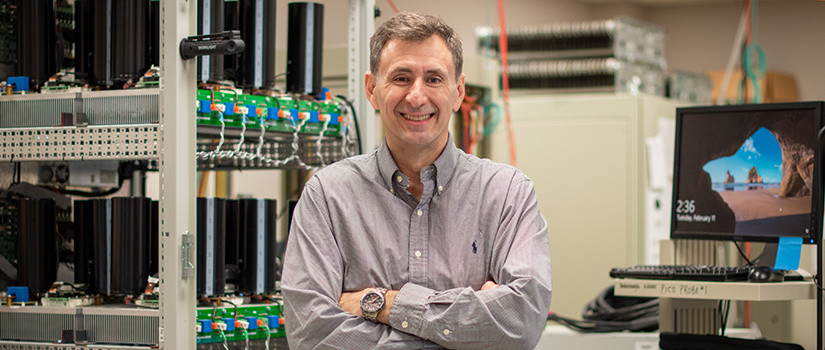By Abe Danaher | February 17, 2020
Herb Ginn is shaping the U.S. Navy’s ships of the future by replacing the ships’ traditional energy distribution systems with new-age power electronics. And, as if transforming the future of the U.S. military isn’t enough, his findings on energy storage management through this research pose a key solution to the growing climate change crisis.
Put simply, power electronics are high power transistors that switch on and off just like microprocessors, except instead of manipulating data, power electronics control energy. In today’s grid, energy flows are mostly dictated by physics – by inertia of generators, inductance of transmission lines, or the open or closed state of bus tie switches. In contrast, power electronics offer an alternative method of distribution that allow finer control over how energy is converted, how it is stored, at what rate it is sent, and the efficiency with which it is distributed.
“The objective of power electronics is to replace those physics-based things with things that are digitally controlled,” explains Roger Dougal, the chair of UofSC’s electrical engineering department who works closely with Ginn on the naval research. “And so, in many ways it makes the system more efficient, much more effective, and easier to control with higher precision.”
Since 2002, Ginn has been implementing a transition to power electronics within the Navy. He’s worked on many initiatives – electric ships, electric aircraft – trying to find the best way to have one form of energy distribution for the entire system, so that ships and aircraft can maintain maximum flexibility over the energy they use.
“So how do you store energy, and how do you transform it from one form to another in an efficient way?”
-Herb Ginn, Electrical Engineering Professor
Currently, that is not possible. The Navy cannot dictate with fine precision where energy is going on their ships. His vision for the future and what he is working toward in his research will look completely different. In fact, it may look straight out of a movie.
“The analogy would be Star Trek,” he says as he explains the vision of his research. “So, divert energy to the shields, or the phasers. I guess that’s the ultimate vision of the Navy – if they had damage or, according to mission needs, they want the flexibility to direct where energy flows in the system.”
This research would create complex energy grids aboard the ships containing multiple sources of energy production, numerous batteries storing the created energy, and controls placed throughout the system to monitor the distribution of energy from the batteries to where it is needed. This same system, Ginn says, is “directly applicable” to transforming the renewable energy grid – offering the flexibility and storage capabilities currently hindering renewable energy’s growth.
“This is the same technology that is going to get us where we need to be with things like renewable energy sources,” Ginn says. “So how do you store energy, and how do you transform it from one form to another in an efficient way?”
“The hope is that this technology gets us to where we need to be as far as increasing renewables... so that we can reduce the greenhouse gasses.”
- Herb Ginn, Electrical Engineering Professor
In 2018, 11% of energy consumed in the United States was produced by renewable energy sources. And while specific areas of the country – such as California on a sunny day – can temporarily operate solely on the energy produced from renewable sources, local situations can change quickly with the arrival of clouds or night time and do not offer the dependability needed to support even local energy demands on a regular basis. With power flows governed only by physics, it’s not possible for renewables to form the foundation of the national energy system.
“You’ll often see the politicians saying things like, ‘everything needs to be renewable’ or ‘we need to be 100 percent renewable with no greenhouse gases,’” he says. “It’s not just a matter of will. It’s not just a matter of society deciding they can spend the money and they are 100 percent renewable. It’s simply unachievable with the technologies that exist now."
But, through his research on energy management, there is hope that this could change. The potential growth of many emerging technologies in the field of energy – autonomous vehicles, lithium ion batteries, renewable energy, electric ships – are intertwined. Ginn’s hope is that his research can be applied broadly to help move the entire energy field one step closer to a cleaner and greener future.
“The hope is that this technology gets us to where we need to be as far as increasing renewables – with storage technology being a big part of that – so that we can reduce the greenhouse gasses,” he says. “It’s everything from electric vehicles to renewables and how we can move all of that forward to help stem the climate change.”
